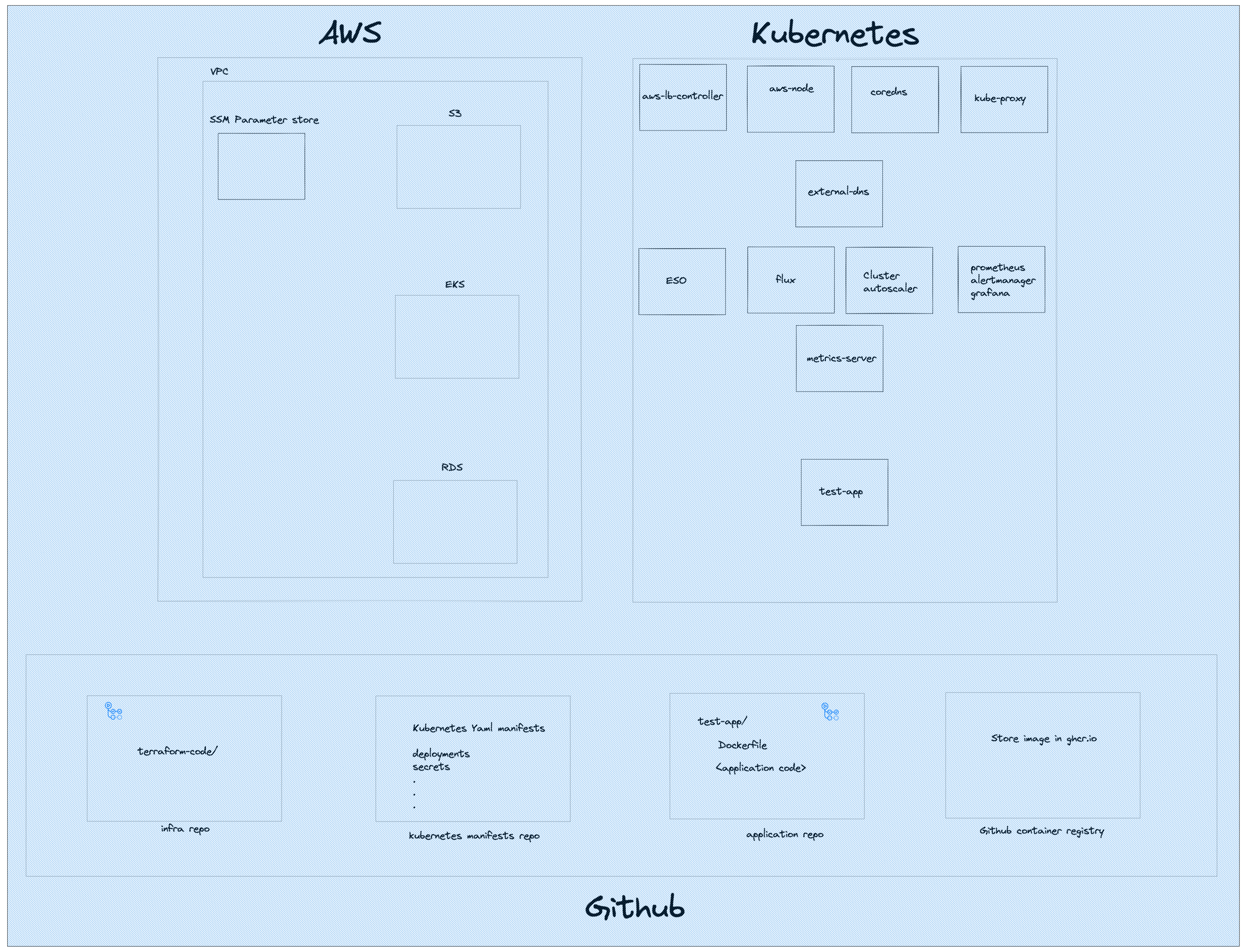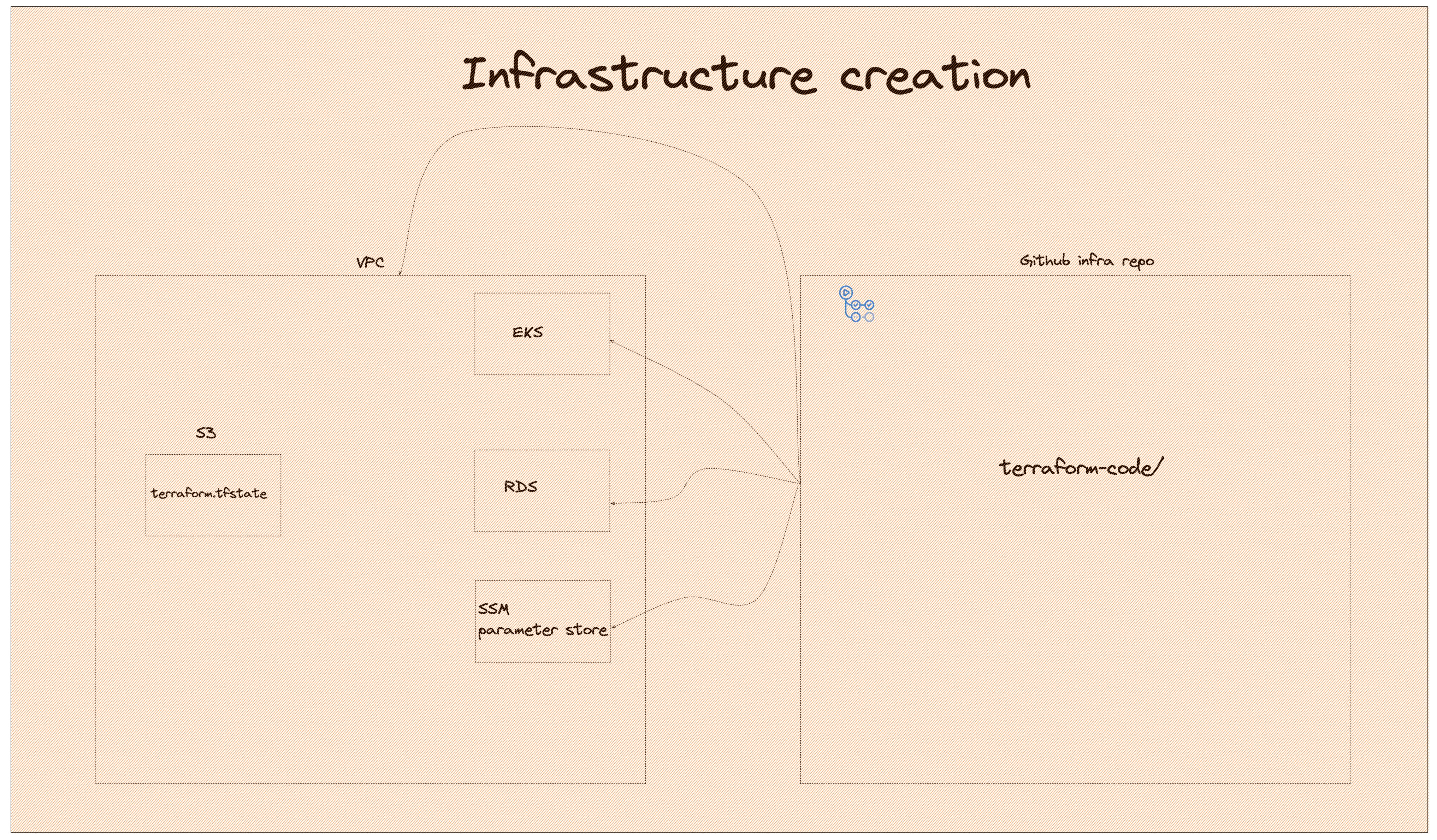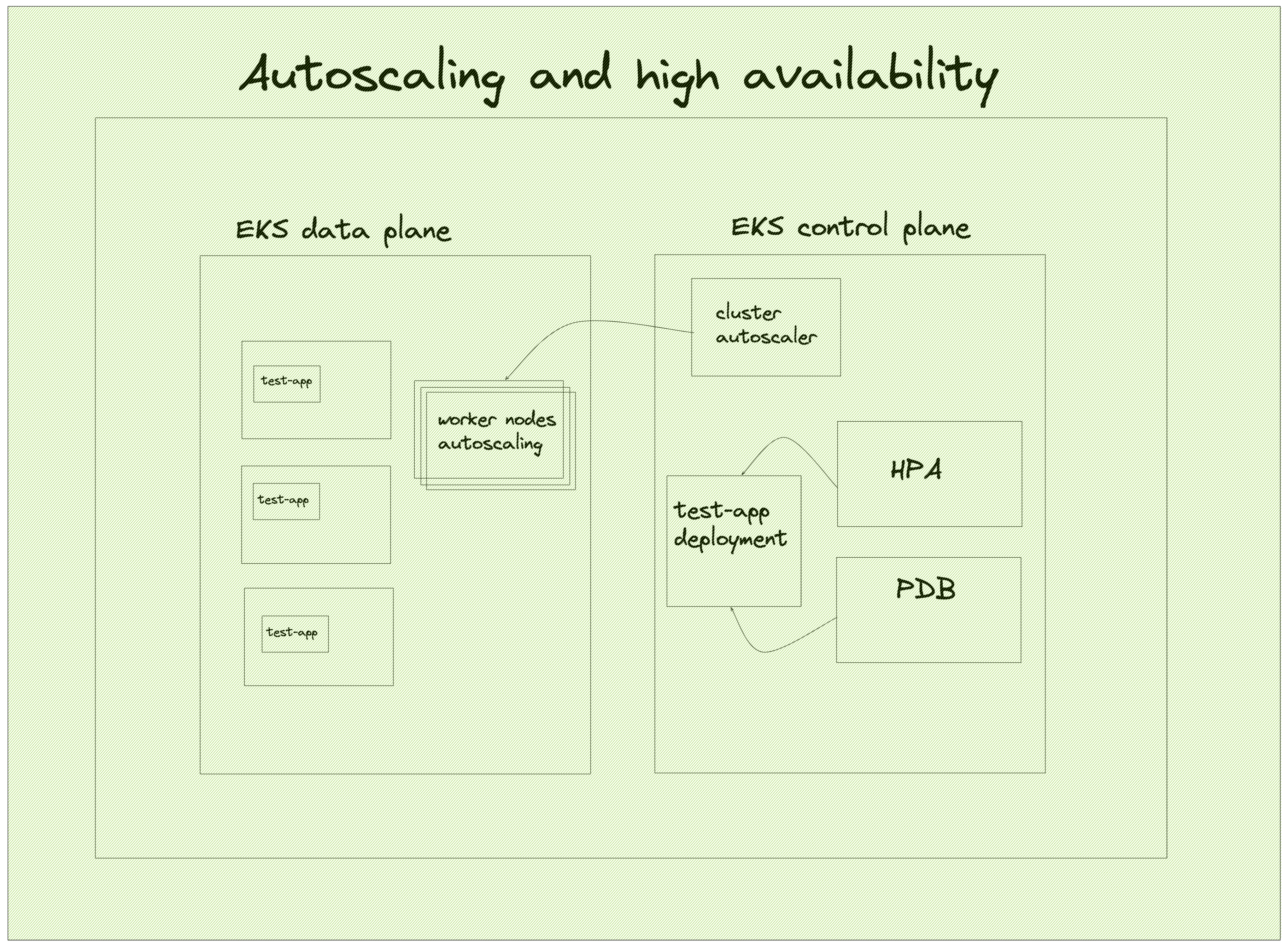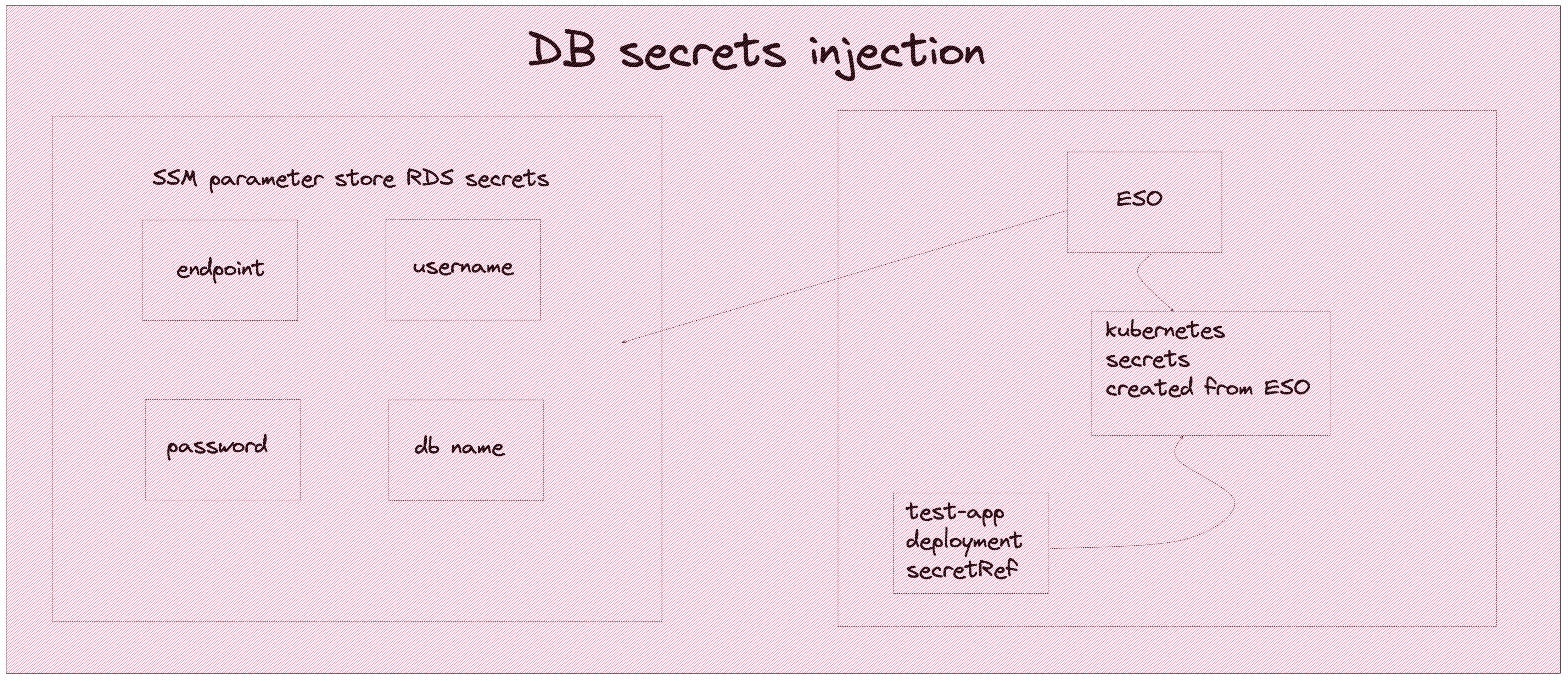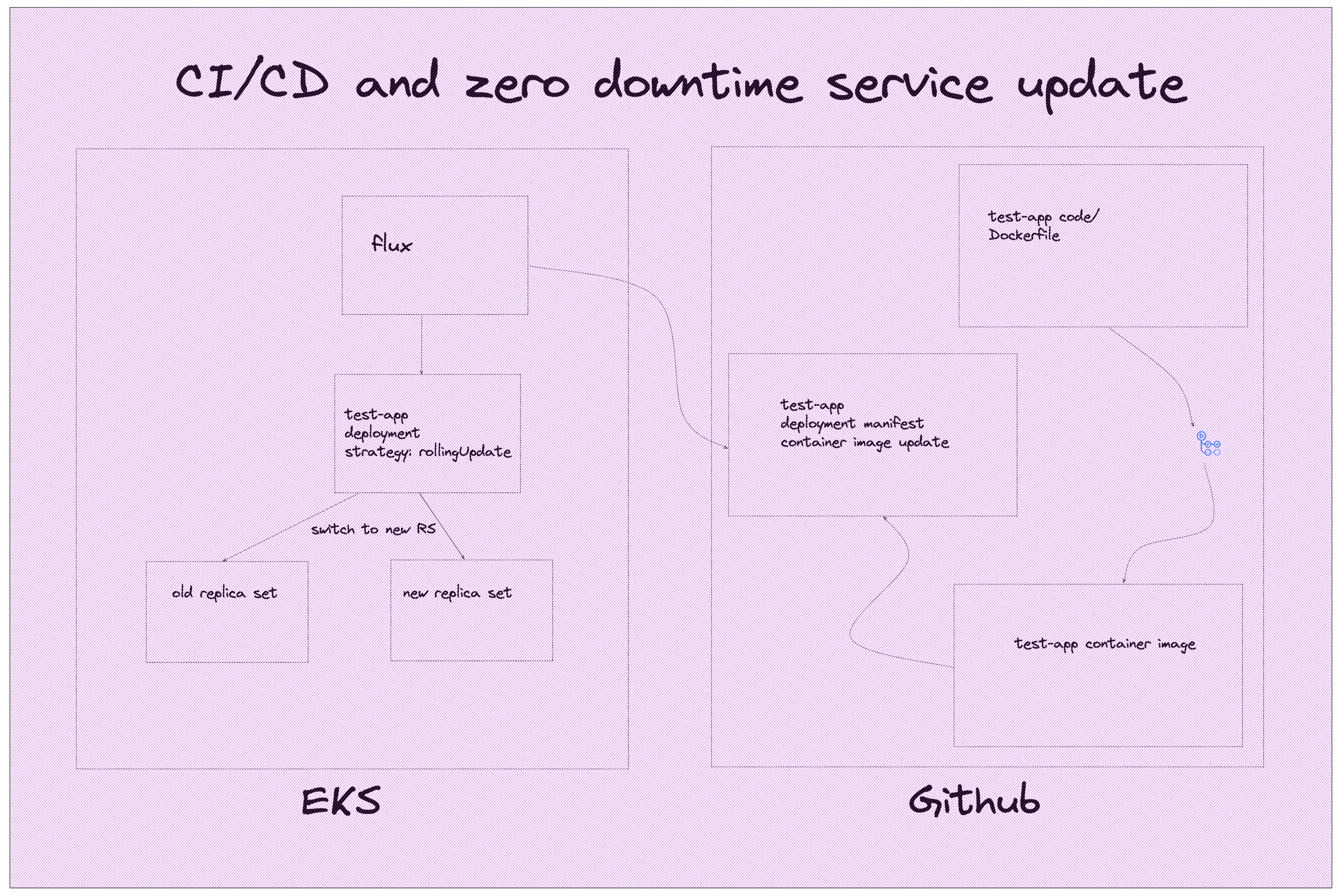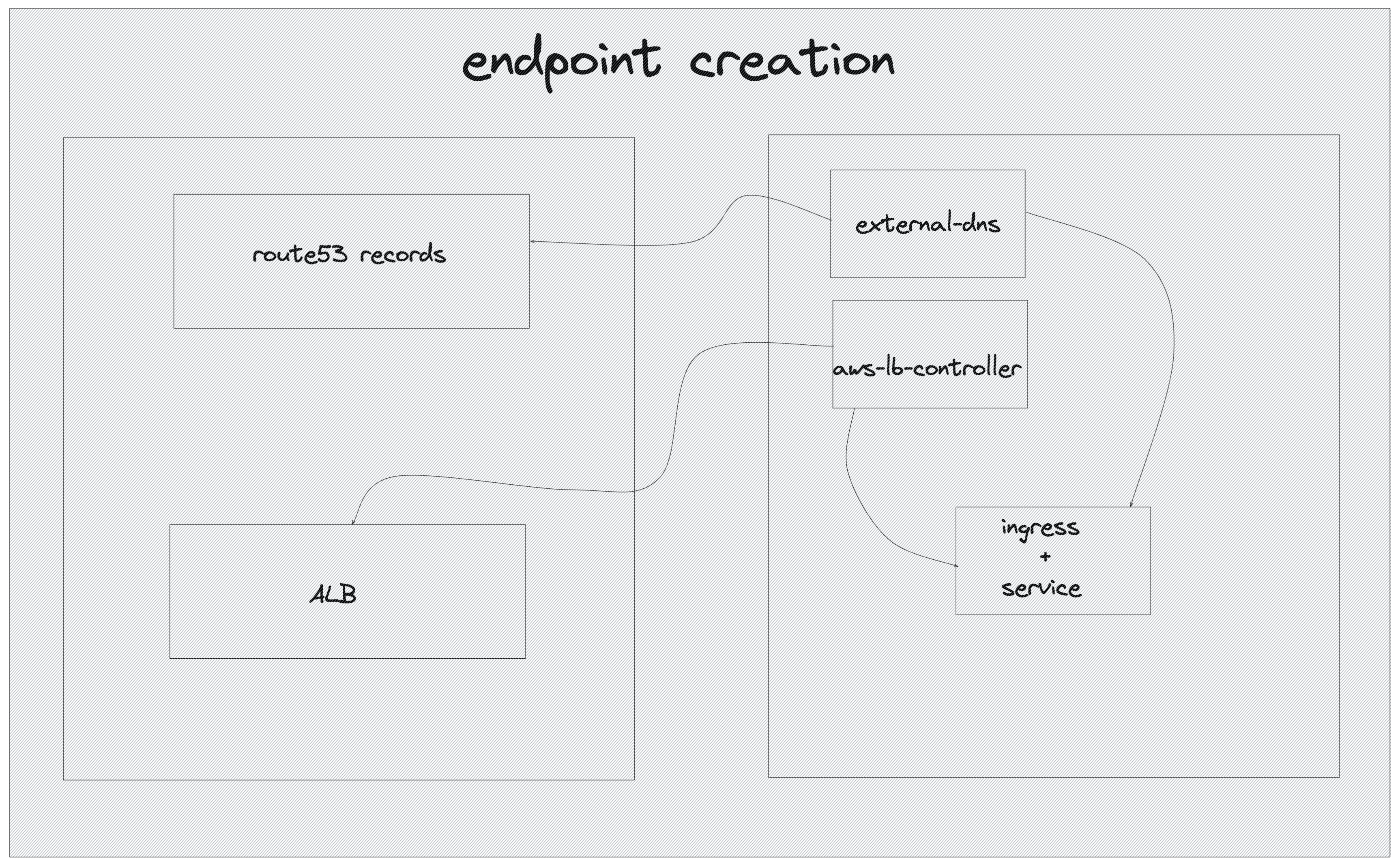For this challenge the technologies used are AWS as a cloud provider and EKS as a platform to deploy all required services.
The diagram that follows is a 10000 foot view of what is/meant to be used.
The challenge focuses on a few areas which will be briefly touched in this section but they will be explained in detail below:
There are 3 components in play AWS, Kubernets (EKS) and Github.
On the AWS side we have an S3 bucket that will contain the terraform state file for the rest of the infrastructure. For the purposes of this challenge, we assume that this bucket is created via Cloudformation. The terraform code will create an EKS cluster which will be our platform to run the test-app service, an postgres RDS database that will be used by test-app as a target. SSM Parameter Store will be used to store the secrets (endpoint, dbname, username, password) of the RDS so we can securely pass them into test-app.
On the Kubernetes side we have a few that are required to properly run the cluster. Starting with the basic services aws-node will take care of the networking in the cluster. coredns is the DNS service for the cluster and kube-proxy to take care of the network rules. We also have the metrics-server that we use to retrieve metrics for our services.
Moving on to our monitoring stack, we have prometheus and alertmanager to scrape metrics and alert for imminent problems and grafana to visualise our metrics.
cluster-autoscaler is used to autoscale the node groups based on the load of the cluster. The service needs to speak to the AWS API and for that purpose I have implemented IRSA in the cluster, which can directly assign AWS IAM roles with Kubernetes pods, giving permissions to use AWS service like EC2 for the autoscaling groups. These permissions can only be used by the pod itself without even the node, on which cluster-autoscaler is running, being able to speak to the EC2 API. IRSA tigthens security on nodes and pods so even if a node is compromised, the attacker will be limited to what they can do.
As with cluster-autoscaler , every service that needs to speak with the AWS API is integrated with IRSA.
external-dns is a service that will continuously watch over Ingress/Service creation and will create the appropriate route53 records if the resources are of type LoadBalancer. (external-dns is not included in the code)
On the topic of load balancers, we also install aws-loadbalancer-controller. This service will watch over Ingress objects and create a correspoinding load balancer in AWS when the Ingress type is of LoadBalancer.
flux is a GitOps solution that makes it easy to deploy Kubernetes objects in the cluster. It's the tool that we use to deploy new versions of the test-app service.
external-secrets-operator or ESO is the service that we use to fetch the RDS information from Parameter Store. It can be integrated with the most popular secret management solutions from the major cloud providers, plus hashicorp Vault.
Last but not least, we have the test-app service which holds the code of our application.
On the Github side we have 3 repositories and each repository serves one function.
The infrastructure repository is where our terraform code exists. Ideally we would also have a github action to implement CI/CD.
The application repository is where the test-app code exists. There is also a github action to create the container image.
The kubernetes-manifest repository is where we keep our kubernetes manifests. The deployment object for test-app and the ExternalSecrets that are fetching the RDS secrets from Parameter Store.
We also make use of the Github container registry to save the container image. application repository's github action pushes the newly created image in the registry.
The infrastructure creation is pretty straight forward. terraform is used to create the infrastructure for VPC and subnets, EKS, RDS and Parameter Store secrets. IAM roles will also be created so our services can have access to the AWS API. We also have an S3 that stores the terraform state file. The S3 as mentioned above is assumed to be created by Cloudformation.
This section focuses on two distinct case that keeps a service up and running.
The first case has to do with autoscaling. test-app has a HorizontalPodAutoscaler or HPA, that monitors the CPU utilization of the existing pods. If the utilization goes over the threshold, a deployment will scale up to more pods to account for the increased load. If the load starts decreasing, and the number of Pods is above the configured minimum, a scale down will begin. If more nodes exist and the affinities are set appropriately, the new test-app pods will be scheduled in the available nodes.
In the event that there are no more nodes available but test-app still wants to scale up, cluster-autoscaler will figure out that there are pods that are waiting to be scheduled and it will scale up the node group to get more nodes. This might take some time until the nodes are Ready to accept pods, so to mitigate this problem, we can make use of the overprovision service which will always keep extra capacity of nodes of, in case of a sudden spike in traffic. overprovision is not included in the challenge but it's worth to mention it as a mitigation solution.
The second case has to do with high availability and it has to do with user-initiated disruption of service, draining for example. Draining of the nodes might be initiated for various reasons by the cluster administrator, two notables are cluster upgrades and node rotations to cover newly found CVEs. The way that the PDB is setup is that the maximum unavailable instances of a service should be 1 at any given time. If there is already one pod that is not ready to recieve traffic, Kubernetes will respect the PDB and will pause the draining. This way we guarantee that test-app will be running at all times even during a cluster upgrade.
This case assumes that test-app is able to run multiple pods at the same time. If the service does not support multiple pods at the same time and only one pod needs to be running, the service will definitely have an outage during drainings.
test-app requires information so it can connect to postgres and ping the database. These information must not be hardcoded in the code for obvious reasons. It also prohibited to be in any kind of configuration file. For this reason we have the ESO in the cluster.
ESO is in charge of speaking with the Parameter Store API and securely retrieving the information needed to connect to the RDS.
ESO has two resources, SecretStore which is used to communicate with the secret management solution, Parameter Store in our case, which is done through IRSA - again, no credentials are visible in any configuration file - and ExternalSecret which uses SecretStore as a connection point, retrieves the secrets from Parameter Store and creates Kubernetes Secrets with the values from Parameter Store. These secrets are read as an environment variable in the test-app deployement and the pod can eventually reach the RDS.
We want out application to have a robust deployment mechanism, so that we can push changes frequenlty but on the same time we dont want to have any downtime in order to push a new version of test-app.
There are two repositories that make this work and on Kubernetes flux is the service that guarantees us continuous deployment.
On Github we have the repository on which test-app is being developed. This repository also has integrated CI with github actions, who will run the suite for our application and make sure that nothing broke in the latest release. Once the CI is successful, the code has been merged into the main branch, the github action will cut a release and tag it with a version. A second github action sees the new release and creates a container image and sends the image into the Github container regitstry. We now have a fresh new version of our application ready to be used in our cluster.
The last step is to update the Kubernetes manifest for the deployment with the new version of test-app. Once this is in the main branch, flux will pull it and apply it in the cluster to compelete the CD.
On important thing to note here, is that the test-app's deployment has a strategy of rollingUpdate. Kubebernetes will first spin up a new replica set with the new version of the application, make sure that it is ready to receive traffic and then scale down the old replica set, thus making sure that traffic has been served at all times.
For easier and production grade access to the test-app pods need a common endpoint so a user can reach the service without the need to remember IPs and ports. For that reason we have a combination of a Service and an Ingress object. The Service sit atop all the test-app pods while the Ingress which is of type LoadBalancer points to Service.
When the Ingress object is created, two services pick up this event. The aws-loadbalancer-controller checks if the Ingress object is a LoadBalancer and if it is, it will create an application load balancer in AWS that will eventually redirect traffic to test-app pods.
external-dns will also pick up the Ingress creation and if it is a LoadBalancer, it will create a Route53 record based on the external-dns.alpha.kubernetes.io/hostname annotation value (if and only if the annotation exists). It will also pass the load balancer's hostname to the newly created record.
So now the test-app application is assigned an endpoint and can be reached from the internet, if you wish to make it public.
Not all services mentioned in this README have been implmented in the solution for the sake of brevity. Below I have a list with services that made it into the challenge
✅ VPC/subnets
✅ IAM roles
✅ EKS
✅ RDS
❌ S3
❌ Route53
✅ amazon-vpc-cni (aws-node)
✅ coredns
✅ kube-proxy
✅ external secrets operator
✅ flux2
✅ cluster-autoscaler
✅ metrics-server
❌ external-dns
❌ overprovision
✅ Infrastructure repo
✅ Kubernetes manifest repo
✅ Application repo with a Dockerfile
✅ Github action to create the container image and send it to ghcr.io
❌ Github action to run terraform
❌ Github action for testing and cutting releases
You can find all diagrams here => excalidraw.io
